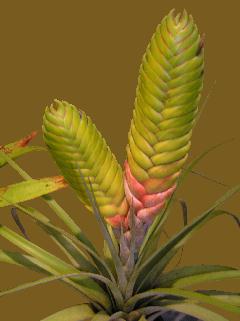
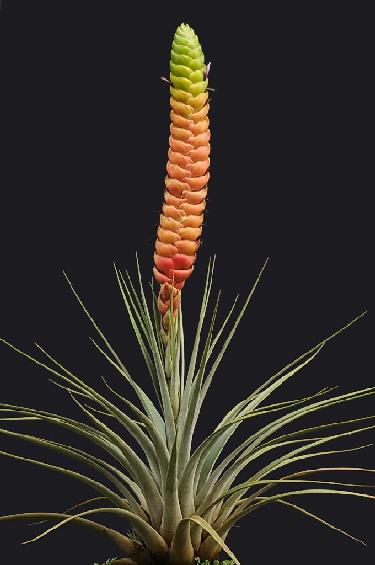
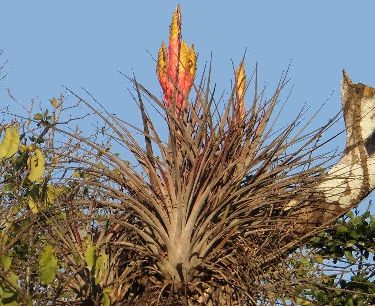
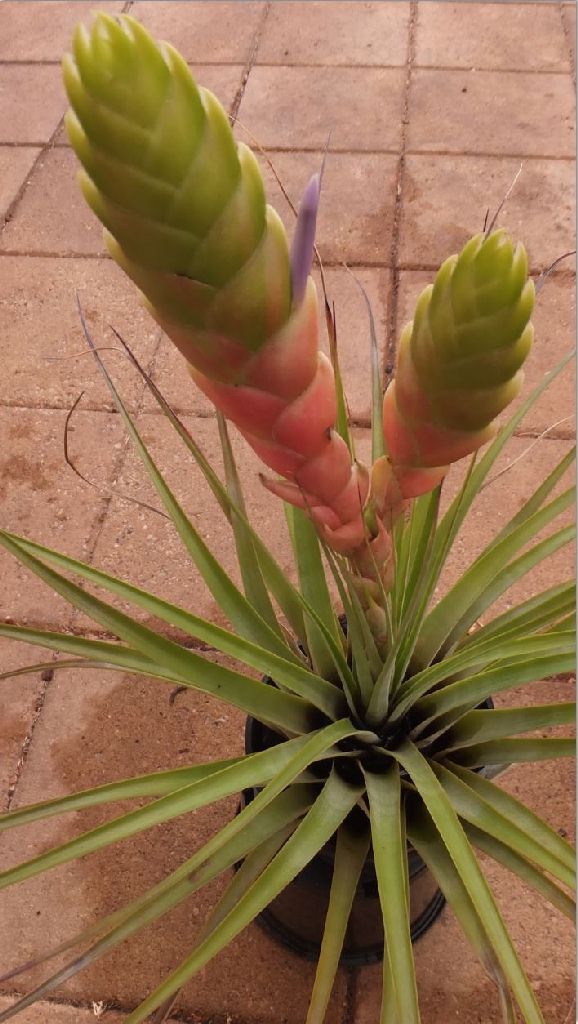
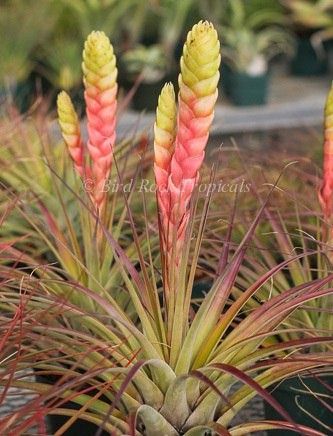
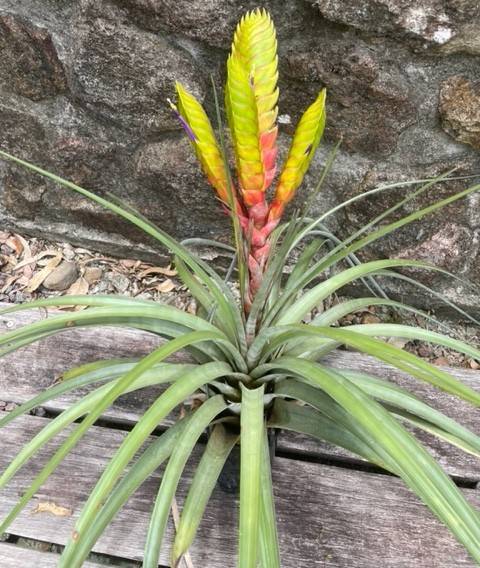
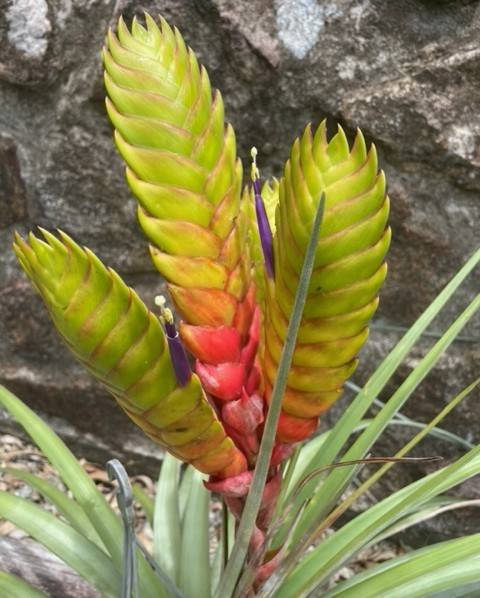
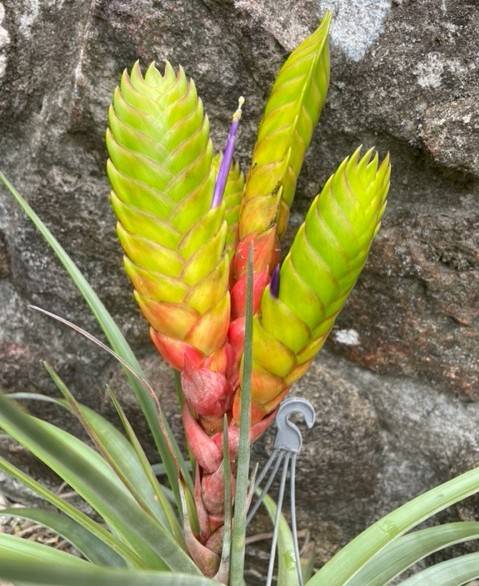
This brings us to the 1990’s where Pam Koide (now Hyatt) of Bird Rock Tropicals was involved and she reports...
“In the early years of collecting, there were (and still are) many forms of Tillandsia fasciculata. We would keep the different forms or types, (not at all referring to the type specimen) separate by giving them a unique number, and some details about the form or type. This group of plants called Tillandsia fasciculata in Mexico, can vary quite a bit in different localities, and even vary on the same tree. We have T. fasciculata Peach type, T. fasciculata Yellow type, T. fasciculata Candelabra type, etc.
The plant referenced here is what we labelled Tillandsia fasciculata (lampropoda type). T446. The reason for this name was that it usually only had a single spike, sometimes double and they present upright and close to each other. The inflorescence was colored pink (salmon-pink) to light green-yellow, and compressed or flattened with a little bit of white lepidote coating. The shape and coloring of the inflorescence reminded me of Tillandsia lampropoda. I knew that it was not T. lampropoda, it was also different than what we were calling Tillandsia jalisco-monticola, which was more red, green and yellow with more inflated, or fatter spikes.
We have propagated this clone from offsets and sold it under this name and number for years. Several years ago, I was reading Matuda's description for Tillandsia jalisco-monticola and realized that the plant that he described in his publication of the species had coloring similar to my T446. It was also discovered near where we found our plant T446. So the name was changed to T. jalisco-monticola ‘Pink Clone’.
So we have a name change not noted by the growers of this plant in Queensland. I would now like to give some indication of the mine-field of plant identification we are in. Tillandsia jaliscomonticola was described by Matuda in 1975 and has caused strife to growers who query identity ever since!
First let us look at
Tillandsia jaliscomonticola Matuda Cact. Suc. Mex. 20: 99. fig 51. “Oct- Dec 1975”
Type locality Pine forest, El Tuito, 700m., Jalisco, Mexico.
Type Carlos R Beutelspacher No. 74, 27 Oct. 1974 (MEXU)
Matuda says that it differs from T. lampropoda in
1. Leaves much larger and more rigid
2. Leaves long tubular tipped, channelled
3. Inflorescence much larger
4. Petals violet
5. Spikes often half red half green.
We now move to -
From Sue Gardner papers 1982
Distributed from coastal Oaxaca to Jalisco, Mexico, this species has been confused with T. fasciculata var. convexispica (Rauh 1981) . Matuda compares it to T. lampropoda but its resemblance to that species is superficial. I find it most similar to T. compressa and T. buchii. it differs from the first in thick, inflated spikes, dense, spreading floral bracts that are rose on the proximal spike, and yellow distally. The spike is short when the first flowers emerge. It continues to elongate and produce flowers over an extended period.
At maturity the scape decurves under the weight of the spike, the spike apex curves upward. Tillandsia buchii, although a much smaller plant, shares an inflated spike, although it is much shorter.
In 2009, as far as Tillandsia jaliscomonticola goes, we had a new Tillandsia magnispica Espejo et Lopez-Ferrari, sp. nov. Acta Bot. Mex. 86: 1-7. 2009
Type: Mexico, Oaxaca, distrito de Pochutla, municipio de San Pedro Pochutla, alrededores de Toltepec, ca. 4.5 km despues de San Jose Chacalapa, carretera Pochutla-Miahuatlan, 15°5l'47" N; 96°27'58" W 285 m s.n.m., selva mediana, 10 VIII 2001, A. Espejo, A. R. Lopez-Ferrari, J. Ceja y A. Mendoza R. 6312 (Holoty¬pe (in three sheets): UAMIZ; Isotype IEB).
Paratypes: Mexico, Oaxaca, distrito de Pochutla, municipio de San Pedro Pochutla, N of Pochutla, 1981, C. S Gardner 1445 (SEL, US, line drawing by Gardner, 1982); distrito de Pochutla, municipio de San Pedro el Alto, 18 km al S de San Miguel Suchistepec, sobre la carretera a Pochutla, 1700 m s.n.m. Bosque de Pinus oocarpa sobre ladera metamorfica, 22.IX.1965, J. Rzedowski 20648 ENCB(x3), LL, MICH, TEX).
Tillandsia magnispica is endemic to Oaxaca (Espejo-Serna et al., 2007 p. 138), and known only from the Municipalities of San Pedro Pochutla and San Pedro el Alto, District of Pochutla (Fig. 4).
The material of the new species has been identified by some authors (Gardner, 1982, pp. 145-146; McVaugh, 1989, p. 58) as Tillandsia jaliscomonticola Matuda (Figs. 2, 3A), a taxon only known from Colima, Jalisco, and Michoacan (Espejo et al., 2004, p. 63), The differences between the two taxa follows.
Comparative characteristics of T. magnispica and T. jaliscomonticola.
..........................................T. magnispica............................T. jaliscomonticola
leaf sheaths.........................7-10 cm long, 4-5 cm wide........11.5-15 cm long, 5.5-6 cm wide
spike number.......................1.............................................1-3
spike width..........................3.5-4.5 cm ...............................6-8.2 cm
petal length.........................7-8 cm long..............................6-7 cm long
stamens..............................subequal...................................unequal
geographical distribution......Oaxaca......................................Colima, Jalisco and Michoacan
Now to a problem we all face when trying to identify a plant we have that has just flowered. We can assume the plant had been found in the wild and had been given a Latinised name by a taxonomist. Of great importance to the taxonomist is a collection number. We can use keys to help us identify. If it is a manmade hybrid we can hope it has been given a name and put in the BCR and search on guessed parentage. If supplied by a plant nursery it may even have their particular code number and this code is as important as the name you write on the label. In this case T446 does not seem to feature on the labels of plants grown in Australia.
We do know that we were growing many plants in Australia called T. jaliscomonticola which were better identified as T. magnispica and no doubt there are others that will need to be adjusted. If you are growing T446 then T. jaliscomonticola ‘Pink Clone’ is the best name to use because it agrees with Bird Rock Tropicals’ current interpretation. Regrettably, this name is not acceptable as a cultivar name under the ICNCP rules, so cannot be registered.